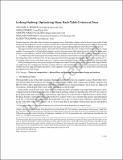Iceberg Hashing: Optimizing Many Hash-Table Criteria at Once
Author(s)
Bender, Michael; Conway, Alex; Farach-Colton, Martin; Kuszmaul, William; Tagliavini, Guido
Download3625817.pdf (752.6Kb)
Publisher Policy
Publisher Policy
Article is made available in accordance with the publisher's policy and may be subject to US copyright law. Please refer to the publisher's site for terms of use.
Terms of use
Metadata
Show full item recordAbstract
Despite being one of the oldest data structures in computer science, hash tables continue to be the focus of a great deal of both theoretical and empirical research. A central reason for this is that many of the fundamental properties that one desires from a hash table are difficult to achieve simultaneously; thus many variants offering different trade-offs have been proposed. This paper introduces Iceberg hashing, a hash table that simultaneously offers the strongest known guarantees on a large number of core properties. Iceberg hashing supports constant-time operations while improving on the state of the art for space efficiency, cache efficiency, and low failure probability. Iceberg hashing is also the first hash table to support a load factor of up to $1 - o(1)$ while being stable, meaning that the position where an element is stored only ever changes when resizes occur. In fact, in the setting where keys are $\Theta(\log n)$ bits, the space guarantees that Iceberg hashing offers, namely that is uses at most $\log \binom{|U|}{n} + O(n \log \log n)$ bits to store $n$ items from a universe $U$, matches a lower bound by Demaine et al. that applies to any stable hash table. Iceberg hashing introduces new general-purpose techniques for some of the most basic aspects of hash-table design. Notably, our indirection-free technique for dynamic resizing, which we call waterfall addressing, and our techniques for achieving stability and very-high probability guarantees, can be applied to any hash table that makes use of the front-yard/backyard paradigm for hash table design.
Department
Massachusetts Institute of Technology. Department of Electrical Engineering and Computer Science; Massachusetts Institute of Technology. Computer Science and Artificial Intelligence LaboratoryJournal
Journal of the ACM
Publisher
ACM
Citation
Bender, Michael, Conway, Alex, Farach-Colton, Martin, Kuszmaul, William and Tagliavini, Guido. "Iceberg Hashing: Optimizing Many Hash-Table Criteria at Once." Journal of the ACM.
Version: Final published version
ISSN
0004-5411